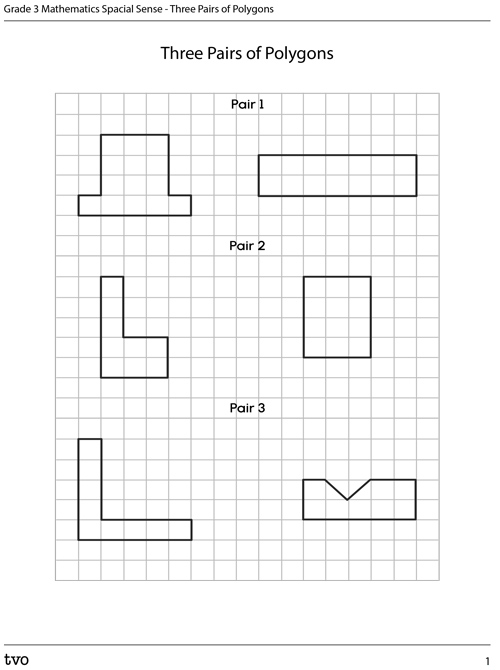Minds On
Time for cake!

A baker has been asked to create a big cake. They can choose one of two different cake pans.
- cake pan A is 10 cm long and 5 cm wide
- cake pan B is 8 cm long and 7 cm wide

Cake Pan A: 10 cm long and 5 cm wide

Cake Pan B: 8 cm long and 7 cm wide
Brainstorm
Which pan to choose?
The baker needs the largest surface possible to decorate. They ask you to help them decide which cake pan to use. How would you go about helping them decide?
Action
Measuring the area
The area or the space inside of a two-dimensional shape can be measured. If the two-dimensional shape is drawn on grid paper, you can count the squares inside the shape to find the area.
Area of a rectangle
Consider the following rectangle drawn on centimetre grid paper. It has a length of 5 cm and a width of 4 cm.

Count the squares!
To find the area of the rectangle, count the number of squares needed to fill up the shape.
Let’s try this method to find the area of the rectangle.
When you are ready, press ‘Answer’ to reveal the area of the rectangle.
The area is 20 square centimetres.
If you used centimetre grid paper, then each square is 1 cm long and 1 cm wide, so the area is equal to 20 cm².
Your turn!
If we drew a square that was 3 cm long and 3 cm wide on centimetre grid paper, what would its area be?
Record your thoughts using a voice recorder, speech-to-text, or writing tool. If you’d like, you can draw a picture to help you count the number of squares.
When you’re ready, press ‘Answer’ to reveal the solution to this question.
The area of the square would be:
3 × 3 = 9
So, the area would be 9 square centimetres.
Making rectangles
Polygons come in a variety of different shapes and angles.
What strategy could you use to calculate the area of a figure that isn’t a rectangle or a square?
How would you calculate the area of the following polygon?
Student Tips
Split the shape into rectangles
You know how to calculate the area of a rectangle. Think about how you could break down this polygon into rectangles.
When you are ready, press ‘Answer’ to reveal the solution to this question.
By drawing a line, we can split the polygon into two rectangles:
- a large wide rectangle
- a small narrow rectangle

Calculating the area
Now we can calculate the area of each rectangle, and then add the areas together to get the area of the entire polygon.
What is the area of the entire polygon? Record your thoughts using a method of your choice.
When you are ready, press ‘Answer’ to reveal the area of this polygon.
Area of the small rectangle: 2 square metres
Area of the large rectangle: 20 square metres
2 + 20 = 22 square metres (If we use metre grid paper, the area will be 22 m².)

Shapes displayed on grid paper. From left to right: The first rectangle is labelled 1 metre by 2 metres. Below it is the following calculation: 1 metre times 2 metres equals 2 square metres. The next rectangle is larger and labelled 4 metres by 5 metres. Below it is the following calculation: 4 metres times 5 metres equals 20 square metres. The last shape is a polygon that represents the two rectangles joined together. Inside the polygon is the following calculation: 2 square metres plus 20 square metres equals 22 square metres.
Brainstorm
Splitting the polygon
Respond to the following questions. Record your ideas using a method of your choice.
- How did separating the polygon into rectangles make it easier to find the total area?
- Could we have split the polygon into different rectangles?
Activity: Comparing area of polygons
Examine the following three pairs of polygons.
Complete the Three Pairs of Polygons activity in your notebook or using the following version of the image for reference.
Estimate, then measure
For each pair of polygons:
- estimate which has a larger area
- measure the area of each
You can work in whatever way you prefer. You can use tiles, examine the polygons on the computer, or use paper.
Brainstorm
Reflecting on area of polygons
Respond to the following questions. Record your ideas using a method of your choice.
- Why is it easier to compare rectangles with the same width or height?
- How did you find the number of square units in the last polygon (where a “V” is cut out)? What was your strategy?
Estimating area
How do we estimate the area of polygons with curved sides, or sides that are not right angles? Square units can help us estimate. Think about using grid paper to help.
Digital or paper grids can be used to represent centimetres or metres. It’s useful since it helps cover the shape with squares.
Consider the following polygon on centimetre grid paper.

Estimate the area of this polygon.
What is an estimate that is too high?
What is an estimate that is too low?
How do you know?
This polygon is an equilateral triangle with a length of 5 squares, and a height of 4 squares. Since it is a triangle, how many full squares might fit inside the polygon?
Brainstorm
How close was your estimate?
Record your ideas using a method of your choice.
- What area did you estimate?
- What did you do when you noticed that only part of a square inside the polygon?
Three steps to estimate area
Press the three steps below to learn how to estimate the area of the triangle.

Examine the partial squares within the polygon. Where possible, combine partial squares to make a whole square. This will help you estimate the area.
In our triangle, there are 7 partial squares.
Put together a pair of partial squares to form a whole square.
You can do this three times.
There are now eight 8 whole squares within the triangle.
Finally, decide what to do with any “leftover” partial squares:
- you can decide to ignore a very small partial square
- you can decide to count a partial square as a half
- you can decide to round a big partial square up to a whole
In this case, there is one leftover partial square that is large enough for us to round up to a whole square. We will include it to make our estimate closer to the actual area.
The triangle has an area of about 9 cm².
Curves and diagonals
You will now estimate the area of four figures.
Complete the Estimating Area activity in your notebook or use the following fillable document. Alternatively, you can create a description of how you would estimate the area of each figure.
Press the ‘Activity’ button to access the Estimating Area.
Brainstorm
Thinking strategically
Think about the Estimating Area activity that we just completed. Record your ideas using a method of your choice.
- What strategy did you use when combining squares?
- How could you record any partial squares that couldn’t be combined to make a full square?
Consolidation
Design and measure

Design four two-dimensional shapes. Two should be measured with centimetres. The other two should be measured with metres.
Record your response using a method of your choice.
Alternatively, you can create a detailed description of the shapes you would use and how you would calculate the area.
Include at least one of each of the following:
- a shape that can be split into rectangles
- a shape that has a curved line
Estimate the area of each shape. Order the estimated areas from smallest to largest.
Think about your learning
Answer the following questions and support your responses.
- Which shapes were easiest to estimate the area for?
- What strategies could you use to calculate area of your shapes?

Reflection
How do you feel about what you have learned in this activity? Which of the next four sentences best matches how you are feeling about your learning? Press the button that is beside this sentence.
I feel...
Now, record your ideas about your feelings using a voice recorder, speech-to-text, or writing tool.
